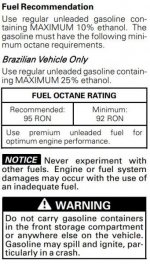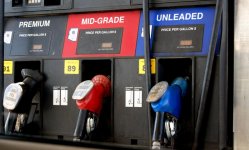-
There were many reasons for the change of the site software, the biggest was security. The age of the old software also meant no server updates for certain programs. There are many benefits to the new software, one of the biggest is the mobile functionality. Ill fix up some stuff in the coming days, we'll also try to get some of the old addons back or the data imported back into the site like the garage. To create a thread or to reply with a post is basically the same as it was in the prior software. The default style of the site is light colored, but i temporarily added a darker colored style, to change you can find a link at the bottom of the site.
You are using an out of date browser. It may not display this or other websites correctly.
You should upgrade or use an alternative browser.
You should upgrade or use an alternative browser.
Fuel
- Thread starter rkba101
- Start date
BLUEKNIGHT911
Sadly Passed Oct 2024 - RIP
fuel
NOT really .... perhaps a .01 % loss in performance ....some folks claim they can REALLY feel the difference .... NOT ....jmho ..... Mike :thumbup:I can not find where it states the type of fuel, but been running super in the st.. Any draw back using just regular fuel on long trips ?
ARtraveler
R.I.P. Dwayne
I have mentioned this in other threads--but will add here.
In 10 years of Spyder ownership--I have put only premium in my rides. Here, premium is 90 octane.
This year, I listened to Mike (Blue Knight). I have so far been burning regular (87 octane). I have noticed NO impaired performance. My mileage has remained the same. The 998 gets around 30 mpg, and my 1330 gets around 40 mpg.
Since I usually buy gas at least twice a week for the Spyders, I am saving 20 cents per gallon minimum. If I buy Shell--they want 40 cents per gallon more for premium.
That's my current story. And, Thanks, Mike. :yes:
In 10 years of Spyder ownership--I have put only premium in my rides. Here, premium is 90 octane.
This year, I listened to Mike (Blue Knight). I have so far been burning regular (87 octane). I have noticed NO impaired performance. My mileage has remained the same. The 998 gets around 30 mpg, and my 1330 gets around 40 mpg.
Since I usually buy gas at least twice a week for the Spyders, I am saving 20 cents per gallon minimum. If I buy Shell--they want 40 cents per gallon more for premium.
That's my current story. And, Thanks, Mike. :yes:
Last edited:
IdahoMtnSpyder
Well-known member
Go here to read about my two years of data about regular vs. premium. At the very least read the first few posts and then go to the end. The results may surprise you!I can not find where it states the type of fuel, but been running super in the st.. Any draw back using just regular fuel on long trips ?
http://www.spyderlovers.com/forums/...-Premium-vs-Regular&highlight=regular+premium
Woodaddict
Well-known member
I could have sworn Can Am recommended premium. Am I wrong?
yes!! I usually follow the rules! why get the computer or nanny in an uproar or all wabbyjawed??
Bob Denman
New member
:banghead: The suggested fuel to be used, is 91 octane...
But if you can get it to light: the computer can figure out a way to make it work! nojoke
But if you can get it to light: the computer can figure out a way to make it work! nojoke
BryanSD
Member
My reason for getting the Premium isn't the higher octane but that it is the best chance to contain pure gas. Here in the cornbelt most of our lower octane gas is blended with 10% ethanol. Is this a valid reasons to purchase Premium gas?
As a side note, I have no problem putting gas blended with ethanol in my cars and trucks. I do go out of my way to not using ethanol when towing or in my small engines.
As a side note, I have no problem putting gas blended with ethanol in my cars and trucks. I do go out of my way to not using ethanol when towing or in my small engines.
Bob Denman
New member
Ethanol isn't considered to be a problem for the Spyder's fuel systems.
BRP has taken this into account, when equipping the bikes, and they make no mention of it (Other than to NOT exceed 10%...) in the manuals.
BRP has taken this into account, when equipping the bikes, and they make no mention of it (Other than to NOT exceed 10%...) in the manuals.
Easy Rider
New member
your ST will kind of "dumb itself down" to whatever octane fuel you are using. Which is handy if you are ryding in Mexico for example.
So while it won't be performing at 100% it will not suffer any real problems.
A common mis-conception.
While it might not ever be a problem with a Spyder because the compression really isn't THAT high........
There are two kinds of combustion chamber pre-ignition (ping or knock).
When the spark hits, if the fuel burns too quickly there is an explosion of sorts. This "spark knock" is what the engine can correct for by backing off the timing a bit.
Then there is compression knock, which is much worse and, if present, can NOT be corrected for with simple ignition timing changes.
With compression knock, the fuel ignites BEFORE the spark hits and the max. expansion occurs before TDC and puts a huge strain on the engine.
Having a higher octane helps prevent both these conditions but really is the ONLY protection from compression knock if conditions can occur to cause that. Note: A very sophisticated engine could correct for that too by changing the valve timing but I don't know if any actually DO that or not, since using the right fuel would make it mostly unnecessary.
No ethanol
Bryan is CORRECT, in the midwest especially around large metropolitan areas, the only gas without ethanol IS premium. All other octanes will have alcohol. And in Northern Illinois, within 60 miles of Chicago there is NO non-ethanol gas. For us the best chance for getting non-alcohol and in fact the only chance IS premium,
Bryan is CORRECT, in the midwest especially around large metropolitan areas, the only gas without ethanol IS premium. All other octanes will have alcohol. And in Northern Illinois, within 60 miles of Chicago there is NO non-ethanol gas. For us the best chance for getting non-alcohol and in fact the only chance IS premium,
Last edited:
Easy Rider
New member
BRP has taken this into account, when equipping the bikes, and they make no mention of it (Other than to NOT exceed 10%...) in the manuals.
Check the manual for your new machine.
I think you will find that it says to use "only fuel blends approved by the Government".......which would seem to allow for E-15 if and when it is approved.
NOW.....do they sell Spyders in South America ? Where much of the fuel used approaches E-100 ? I wonder what those manuals say.
billybovine
Active member
Don't wonder.
No need to wonder what those manuals say. Just look it up.

Check the manual for your new machine.
I think you will find that it says to use "only fuel blends approved by the Government".......which would seem to allow for E-15 if and when it is approved.
NOW.....do they sell Spyders in South America ? Where much of the fuel used approaches E-100 ? I wonder what those manuals say.
No need to wonder what those manuals say. Just look it up.

irvin48
New member
Check the manual for your new machine.
I think you will find that it says to use "only fuel blends approved by the Government".......which would seem to allow for E-15 if and when it is approved.
NOW.....do they sell Spyders in South America ? Where much of the fuel used approaches E-100 ? I wonder what those manuals say.
some of the caseys stations carry 91 octane alcohol free gas in our area of
illinois. we are in mt morris ,il 25 miles sw of rockford. on rte 64. hundreds of riders come
through here to go to poopy's and galena and beyond. usually fill up all engines sitting
during the winter with it and seafoam.
oops --replied under wrong name. oh well,sillinois people ,there is pure gas in my town.
Last edited:
ARtraveler
R.I.P. Dwayne
Hope I have not started a mini war....:yikes:
Still going to use 87....for now. :thumbup:
Still going to use 87....for now. :thumbup:
In the winter I put the expensive stuff cause my bike might sit longer but in the summer I put the cheap stuff cause my bike never sits at all. Never had a problem.
I can not find where it states the type of fuel, but been running super in the st.. Any draw back using just regular fuel on long trips ?
Bob Denman
New member
A common mis-conception.
While it might not ever be a problem with a Spyder because the compression really isn't THAT high........
There are two kinds of combustion chamber pre-ignition (ping or knock).
When the spark hits, if the fuel burns too quickly there is an explosion of sorts. This "spark knock" is what the engine can correct for by backing off the timing a bit.
Then there is compression knock, which is much worse and, if present, can NOT be corrected for with simple ignition timing changes.
With compression knock, the fuel ignites BEFORE the spark hits and the max. expansion occurs before TDC and puts a huge strain on the engine.
Having a higher octane helps prevent both these conditions but really is the ONLY protection from compression knock if conditions can occur to cause that. Note: A very sophisticated engine could correct for that too by changing the valve timing but I don't know if any actually DO that or not, since using the right fuel would make it mostly unnecessary.
This is for the "991 engine"... with a 12.2:1 compression ratio. :shocked:
I was using 87 for 09 but with higher compression engine in 15, I will use 91.
I get the point that Spyder will retard/make adjustments so that it will run fine with 87 but I don’t want a retarded Spyder.
And I will pay 40cents more per gallon if it helps Spyder to run cooler especially because I will have to hold onto this Spyder for long time. No more RS.
I get the point that Spyder will retard/make adjustments so that it will run fine with 87 but I don’t want a retarded Spyder.
And I will pay 40cents more per gallon if it helps Spyder to run cooler especially because I will have to hold onto this Spyder for long time. No more RS.
Similar threads
- Replies
- 24
- Views
- 3K
- Replies
- 3
- Views
- 513
- Replies
- 15
- Views
- 2K
- Replies
- 13
- Views
- 2K

